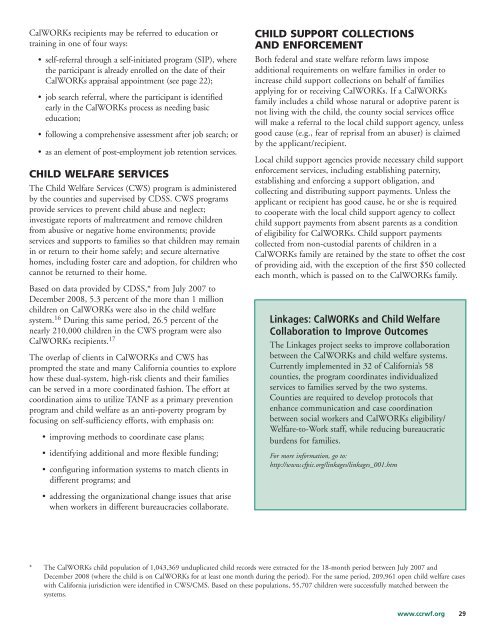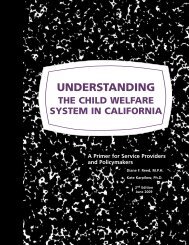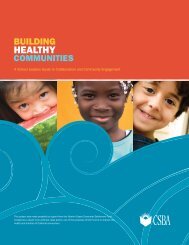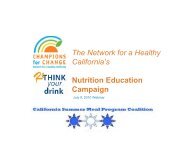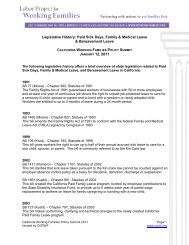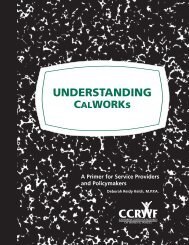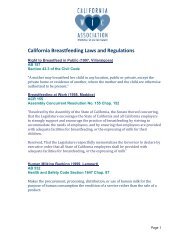C<strong>on</strong>gress under ARRA. In FY 2010-11, the estimateincreases to $6.6 billi<strong>on</strong>. 10In FY 2009-10, <str<strong>on</strong>g>CalWORKs</str<strong>on</strong>g> recipients are expected to be23.1 percent of all Food Stamp recipients in <str<strong>on</strong>g>Cali<str<strong>on</strong>g>for</str<strong>on</strong>g>nia</str<strong>on</strong>g>. 11MEDI-CALIn <str<strong>on</strong>g>Cali<str<strong>on</strong>g>for</str<strong>on</strong>g>nia</str<strong>on</strong>g>, the federal Medicaid program is administeredas the <str<strong>on</strong>g>Cali<str<strong>on</strong>g>for</str<strong>on</strong>g>nia</str<strong>on</strong>g> Medical Assistance Program (Medi-Cal),which provides health care services to <str<strong>on</strong>g>CalWORKs</str<strong>on</strong>g> recipientsand other qualified low-income pers<strong>on</strong>s. Medi-Cal is themain source of health care insurance <str<strong>on</strong>g>for</str<strong>on</strong>g> 6.7 milli<strong>on</strong><str<strong>on</strong>g>Cali<str<strong>on</strong>g>for</str<strong>on</strong>g>nia</str<strong>on</strong>g>ns, drawing $27 billi<strong>on</strong> in federal funds into thestate’s health care system during FY 2008-09. 12 The programis administered by the <str<strong>on</strong>g>Cali<str<strong>on</strong>g>for</str<strong>on</strong>g>nia</str<strong>on</strong>g> Department of HealthCare Services, which sets eligibility, benefit, providerpayment, and beneficiary cost-sharing levels. At the locallevel, county health and social services departments c<strong>on</strong>ducteligibility determinati<strong>on</strong>s and oversee enrollment andrecertificati<strong>on</strong>. Medi-Cal is funded equally by state andfederal funds.Federal law (under Secti<strong>on</strong> 1931(b) of the Social SecurityAct) requires states to provide Medicaid coverage <str<strong>on</strong>g>for</str<strong>on</strong>g> needyfamilies participating in TANF programs. In <str<strong>on</strong>g>Cali<str<strong>on</strong>g>for</str<strong>on</strong>g>nia</str<strong>on</strong>g>,as l<strong>on</strong>g as families are <strong>on</strong> <str<strong>on</strong>g>CalWORKs</str<strong>on</strong>g> they are eligible<str<strong>on</strong>g>for</str<strong>on</strong>g> Medi-Cal.Families disc<strong>on</strong>tinued from <str<strong>on</strong>g>CalWORKs</str<strong>on</strong>g> as a result of excessearned income may receive Transiti<strong>on</strong>al Medi-Cal (TMC)<str<strong>on</strong>g>for</str<strong>on</strong>g> 6 m<strong>on</strong>ths. At that time, if the family’s income is below185 percent of the federal poverty level, they are eligible toreceive an additi<strong>on</strong>al 6 m<strong>on</strong>ths of Medi-Cal through theTMC program. If their income is above the 185 percentthreshold, they can no l<strong>on</strong>ger receive TMC, but they mayqualify <str<strong>on</strong>g>for</str<strong>on</strong>g> other Medi-Cal programs (e.g., the Medi-CalShare-of-Cost program, where recipients must pay a share ofcost or deductible).In FY 2008-09, <str<strong>on</strong>g>CalWORKs</str<strong>on</strong>g> recipients comprised 16 percentof total Medi-Cal enrollment. 13WORKFORCE INVESTMENT ACTThe U.S. Department of Labor and the <str<strong>on</strong>g>Cali<str<strong>on</strong>g>for</str<strong>on</strong>g>nia</str<strong>on</strong>g>Employment Development Department (EDD) fund andadminister the Work<str<strong>on</strong>g>for</str<strong>on</strong>g>ce Investment Act (WIA), which canhelp <str<strong>on</strong>g>CalWORKs</str<strong>on</strong>g> recipients secure and retain jobs.The federal Work<str<strong>on</strong>g>for</str<strong>on</strong>g>ce Investment Act of 1998 (WIA)aimed to c<strong>on</strong>solidate and re<str<strong>on</strong>g>for</str<strong>on</strong>g>m federal laws governing jobtraining, adult educati<strong>on</strong>, and vocati<strong>on</strong>al rehabilitati<strong>on</strong>programs. WIA gives priority <str<strong>on</strong>g>for</str<strong>on</strong>g> intensive training andservices to recipients of public assistance and other lowincomeindividuals, but is available to all adults, dislocatedworkers, and low-income youth with employment barriers.In <str<strong>on</strong>g>Cali<str<strong>on</strong>g>for</str<strong>on</strong>g>nia</str<strong>on</strong>g>, EDD administers the WIA Title I programunder the policy guidance of the <str<strong>on</strong>g>Cali<str<strong>on</strong>g>for</str<strong>on</strong>g>nia</str<strong>on</strong>g> Work<str<strong>on</strong>g>for</str<strong>on</strong>g>ceInvestment Board. At the local level, the program isadministered by Local Work<str<strong>on</strong>g>for</str<strong>on</strong>g>ce Investment Boards(LWIBs). Local boards make funding allocati<strong>on</strong> decisi<strong>on</strong>sand have significant discreti<strong>on</strong>. Some counties co-locateLWIBs and county social services departments, while othersmanage LWIBs and county welfare in the same department.WIA services in <str<strong>on</strong>g>Cali<str<strong>on</strong>g>for</str<strong>on</strong>g>nia</str<strong>on</strong>g> are also delivered throughOne-Stop Career <str<strong>on</strong>g>Center</str<strong>on</strong>g>s, which provide a full range of jobsearch and placement assistance, skills assessments, groupand individual counseling, case management, training, andeducati<strong>on</strong> services <str<strong>on</strong>g>for</str<strong>on</strong>g> job seekers. One-Stop Career <str<strong>on</strong>g>Center</str<strong>on</strong>g>salso offer employer services and business assistance.EDUCATION ANDTRAINING PROGRAMSEducati<strong>on</strong> is an important element of the <str<strong>on</strong>g>CalWORKs</str<strong>on</strong>g>program. Many adults in <str<strong>on</strong>g>CalWORKs</str<strong>on</strong>g> families have limitededucati<strong>on</strong> or work experience, limited literacy and languageskills, and/or insufficient training <str<strong>on</strong>g>for</str<strong>on</strong>g> jobs available in thecommunity. Nearly <strong>on</strong>e-third of <str<strong>on</strong>g>CalWORKs</str<strong>on</strong>g> heads ofhousehold (31 percent) have a primary language other thanEnglish, 14 50 percent of the adults <strong>on</strong> <str<strong>on</strong>g>CalWORKs</str<strong>on</strong>g> havecompleted 11th grade or less, and <strong>on</strong>ly 32 percent have ahigh school diploma (see page 33). 15Local educati<strong>on</strong>al instituti<strong>on</strong>s offer <str<strong>on</strong>g>CalWORKs</str<strong>on</strong>g> teens andadults a variety of educati<strong>on</strong>al programs:• Adult educati<strong>on</strong> programs provide English as a Sec<strong>on</strong>dLanguage, high school equivalency, Adult BasicEducati<strong>on</strong>, vocati<strong>on</strong>al educati<strong>on</strong>, remedial andoccupati<strong>on</strong>al educati<strong>on</strong>, and training support services.• The K-12 educati<strong>on</strong>al system serves <str<strong>on</strong>g>CalWORKs</str<strong>on</strong>g> highschool-age recipients in the Cal-Learn program.• Regi<strong>on</strong>al Occupati<strong>on</strong>al Programs provide occupati<strong>on</strong>aland <strong>on</strong>-the-job training and job placement services.• Community colleges provide case management,employment-focused courses, job training, basicskills training, remedial classes, work study, and jobplacement. Community colleges design programs to fitthe 12-m<strong>on</strong>th federal limit <strong>on</strong> vocati<strong>on</strong>al educati<strong>on</strong>.• Four-year colleges (University of <str<strong>on</strong>g>Cali<str<strong>on</strong>g>for</str<strong>on</strong>g>nia</str<strong>on</strong>g> and<str<strong>on</strong>g>Cali<str<strong>on</strong>g>for</str<strong>on</strong>g>nia</str<strong>on</strong>g> State University) provide educati<strong>on</strong>/degreeprograms, work study, and job placement.• Miscellaneous training programs through communitybasedorganizati<strong>on</strong>s provide work experience, <strong>on</strong>-thejobtraining, and language-specific services.28 www.ccrwf.org
<str<strong>on</strong>g>CalWORKs</str<strong>on</strong>g> recipients may be referred to educati<strong>on</strong> ortraining in <strong>on</strong>e of four ways:• self-referral through a self-initiated program (SIP), wherethe participant is already enrolled <strong>on</strong> the date of their<str<strong>on</strong>g>CalWORKs</str<strong>on</strong>g> appraisal appointment (see page 22);• job search referral, where the participant is identifiedearly in the <str<strong>on</strong>g>CalWORKs</str<strong>on</strong>g> process as needing basiceducati<strong>on</strong>;• following a comprehensive assessment after job search; or• as an element of post-employment job retenti<strong>on</strong> services.CHILD WELFARE SERVICESThe Child Welfare Services (CWS) program is administeredby the counties and supervised by CDSS. CWS programsprovide services to prevent child abuse and neglect;investigate reports of maltreatment and remove childrenfrom abusive or negative home envir<strong>on</strong>ments; provideservices and supports to families so that children may remainin or return to their home safely; and secure alternativehomes, including foster care and adopti<strong>on</strong>, <str<strong>on</strong>g>for</str<strong>on</strong>g> children whocannot be returned to their home.Based <strong>on</strong> data provided by CDSS,* from July 2007 toDecember 2008, 5.3 percent of the more than 1 milli<strong>on</strong>children <strong>on</strong> <str<strong>on</strong>g>CalWORKs</str<strong>on</strong>g> were also in the child welfaresystem. 16 During this same period, 26.5 percent of thenearly 210,000 children in the CWS program were also<str<strong>on</strong>g>CalWORKs</str<strong>on</strong>g> recipients. 17The overlap of clients in <str<strong>on</strong>g>CalWORKs</str<strong>on</strong>g> and CWS hasprompted the state and many <str<strong>on</strong>g>Cali<str<strong>on</strong>g>for</str<strong>on</strong>g>nia</str<strong>on</strong>g> counties to explorehow these dual-system, high-risk clients and their familiescan be served in a more coordinated fashi<strong>on</strong>. The ef<str<strong>on</strong>g>for</str<strong>on</strong>g>t atcoordinati<strong>on</strong> aims to utilize TANF as a primary preventi<strong>on</strong>program and child welfare as an anti-poverty program byfocusing <strong>on</strong> self-sufficiency ef<str<strong>on</strong>g>for</str<strong>on</strong>g>ts, with emphasis <strong>on</strong>:• improving methods to coordinate case plans;• identifying additi<strong>on</strong>al and more flexible funding;• c<strong>on</strong>figuring in<str<strong>on</strong>g>for</str<strong>on</strong>g>mati<strong>on</strong> systems to match clients indifferent programs; andCHILD SUPPORT COLLECTIONSAND ENFORCEMENTBoth federal and state welfare re<str<strong>on</strong>g>for</str<strong>on</strong>g>m laws imposeadditi<strong>on</strong>al requirements <strong>on</strong> welfare families in order toincrease child support collecti<strong>on</strong>s <strong>on</strong> behalf of familiesapplying <str<strong>on</strong>g>for</str<strong>on</strong>g> or receiving <str<strong>on</strong>g>CalWORKs</str<strong>on</strong>g>. If a <str<strong>on</strong>g>CalWORKs</str<strong>on</strong>g>family includes a child whose natural or adoptive parent isnot living with the child, the county social services officewill make a referral to the local child support agency, unlessgood cause (e.g., fear of reprisal from an abuser) is claimedby the applicant/recipient.Local child support agencies provide necessary child supporten<str<strong>on</strong>g>for</str<strong>on</strong>g>cement services, including establishing paternity,establishing and en<str<strong>on</strong>g>for</str<strong>on</strong>g>cing a support obligati<strong>on</strong>, andcollecting and distributing support payments. Unless theapplicant or recipient has good cause, he or she is requiredto cooperate with the local child support agency to collectchild support payments from absent parents as a c<strong>on</strong>diti<strong>on</strong>of eligibility <str<strong>on</strong>g>for</str<strong>on</strong>g> <str<strong>on</strong>g>CalWORKs</str<strong>on</strong>g>. Child support paymentscollected from n<strong>on</strong>-custodial parents of children in a<str<strong>on</strong>g>CalWORKs</str<strong>on</strong>g> family are retained by the state to offset the costof providing aid, with the excepti<strong>on</strong> of the first $50 collectedeach m<strong>on</strong>th, which is passed <strong>on</strong> to the <str<strong>on</strong>g>CalWORKs</str<strong>on</strong>g> family.Linkages: <str<strong>on</strong>g>CalWORKs</str<strong>on</strong>g> and Child WelfareCollaborati<strong>on</strong> to Improve OutcomesThe Linkages project seeks to improve collaborati<strong>on</strong>between the <str<strong>on</strong>g>CalWORKs</str<strong>on</strong>g> and child welfare systems.Currently implemented in 32 of <str<strong>on</strong>g>Cali<str<strong>on</strong>g>for</str<strong>on</strong>g>nia</str<strong>on</strong>g>’s 58counties, the program coordinates individualizedservices to families served by the two systems.Counties are required to develop protocols thatenhance communicati<strong>on</strong> and case coordinati<strong>on</strong>between social workers and <str<strong>on</strong>g>CalWORKs</str<strong>on</strong>g> eligibility/Welfare-to-Work staff, while reducing bureaucraticburdens <str<strong>on</strong>g>for</str<strong>on</strong>g> families.For more in<str<strong>on</strong>g>for</str<strong>on</strong>g>mati<strong>on</strong>, go to:http://www.cfpic.org/linkages/linkages_001.htm• addressing the organizati<strong>on</strong>al change issues that arisewhen workers in different bureaucracies collaborate.* The <str<strong>on</strong>g>CalWORKs</str<strong>on</strong>g> child populati<strong>on</strong> of 1,043,369 unduplicated child records were extracted <str<strong>on</strong>g>for</str<strong>on</strong>g> the 18-m<strong>on</strong>th period between July 2007 andDecember 2008 (where the child is <strong>on</strong> <str<strong>on</strong>g>CalWORKs</str<strong>on</strong>g> <str<strong>on</strong>g>for</str<strong>on</strong>g> at least <strong>on</strong>e m<strong>on</strong>th during the period). For the same period, 209,961 open child welfare caseswith <str<strong>on</strong>g>Cali<str<strong>on</strong>g>for</str<strong>on</strong>g>nia</str<strong>on</strong>g> jurisdicti<strong>on</strong> were identified in CWS/CMS. Based <strong>on</strong> these populati<strong>on</strong>s, 55,707 children were successfully matched between thesystems.www.ccrwf.org29


